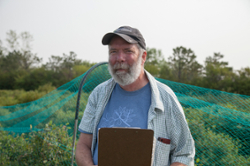Dr. Cecil F. Patterson (1891-1961)

Dr. Cecil Frederick Patterson was born in Watford ON. He attended the Ontario Agricultural College where he completed his Bachelor of Science in Agriculture degree. He moved to Urbana Illinois to where he completed both his Master’s and Doctorate degrees.
Patterson came to the University of Saskatchewan as a lecturer in 1921 and was appointed as the first Head of the newly created Horticulture Science Department in 1922. He served as Head of the department for nearly forty years. During that time, he and his staff were responsible for the development of more than 30 hardy fruit varieties and a potato variety that was adapted for the prairies.
Percy Wright (1898-1989)
Percy Harold Wright was born in Lachine, QC. His family moved to Saskatchewan in 1907 where later attended the University of Saskatchewan and completed a Bachelor' degree With Great Distinction in 1929 and Master’s degree in 1931.
Mr. Wright opened the Wilkie Fruit Nursery in 1924 and moved that operation to Carrot River in 1939. His interest in genetics and plant breeding led to the development of more than 50 prairie hardy cultivars including the 'Hazeldean' rose and 'Thunderchild' flowering crabapple.
Bert Porter (1901-2000)
Albert John (Bert) Porter was born in Guilford in Surrey, England. His family immigrated to Canada in 1907 and established their homestead near Parkside, SK.
Mr. Porter was trained in Saskatoon as a teacher, but the lack of positions forced him to return to his home in Parkside. He worked selling nursery stock in Estavan at Prairie Nurseries and sometimes found himself with unclaimed deliveries. Instead of discarding these items, he planted them at his farm. He noted that the tender rootstock was not hardy for the Prairies and and soon began breeding for hardiness, fruit quality and productivity concentrating on fruit crops like apples, plums, raspberries and strawberries. This was the beginning of the Honeywood Nursery.
Porter's early work focused on Prairie hardy fruit crops and later expaned into hardy roses and lilies. He release two rose varieties that are no longer available and several lily varieties including: 'Cheerful Charlie', 'White Picture', 'Sky Dancer' and 'Saskatoon', all of which may be viewed at the Memorial Garden at Honeywood Nursery.
Les Kerr (1902-1983)
William Leslie Kerr was born in Renfrew, ON in 1902 as the son of a nurseryman. Working along side his father in the nursery started his love of plants. He pursued that love by attending the Ontario Agricultural College in Guelph ON completing a BSc in Agriculture in 1925 and later moving the United States where he completed a Master of Science from the University of Maryland in 1928.
In 1932 Mr. Kerr began working for the experimental farm in Rosthern and later at the Morden Research Station. In 1942 he became the superintendent of the Sutherland Forest Nursery Station until his retirement in 1966.
Sara Williams
In 1963, shortly after earning a degree from the University of Michigan in English and History, Sara joined the Peace Corps and set off to teach in Tanzania where she cultivated her first garden in the school courtyard. She went on to earn a B.Sc. in Horticulture from the University of Saskatchewan (with great distinction) and received the Western Canadian Society for Horticulture Gold Medal. In 1989, Sara was appointed the Horticulture Extension Specialist at the U of S and earned a M. Sc. degree in Agricultural Extension in 1997. She excelled at extension work where she developed curricula, taught courses, helped found the Master Gardener program, and gave hundreds of talks and workshops to the horticulture industry as well as home gardeners. She founded the Saskatchewan Gardener magazine, (later renamed The Gardener), helped establish two special gardens at the Forestry Farm Park and Zoo, was involved with horticultural societies and led many international garden tours. She was inducted into the Saskatchewan Agricultural Hall of Fame in 2013 and was bestowed an Honorary Doctorate by the U of S in 2015.
Sara has written or co-written 10 books about topics such as horticultural history, trees and shrubs, groundcovers and vines, and fruit growing. Her landmark Creating the Prairie Xeriscape: Low maintenance, water-efficient gardening was inspired by her own experience transforming her “5 acres of sand” into an oasis of trees, ornamental gardens, ponds and a very large vegetable garden. Concerned about pesticide use, she wrote Gardening Naturally: A chemical-free handbook for the Prairies. Following her retirement in 2001, Sara has continued to conduct workshops, and write articles and books (a new book: Perennials for Northern Gardens is coming soon). Her ties to Tanzania are as strong as ever: she has made many return visits over the years and actively fundraises to maintain the Sara Williams hostel and garden for girls in Katesh, Tanzania with the Canadian Harambee Education Society.
R. (Bob) Bors

Dr. Bob Bors is an Assistant Professor in the Department of Plant Sciences at the University of Saskatchewan, where he heads the Fruit Program and the Prairie Fruit Genebank. In addition to teaching, Dr Bors’ research is focussed on breeding hardy fruits for northern conditions with an emphasis on crops that can be mechanically harvested and need little or no pesticides. The Fruit Program has 40 acres of fruit under cultivation and is the coldest location in North America for a major fruit breeding program. Founded by Dr. C. F. Patterson, the program has been developing cold-hardy fruit varieties for nearly 100 years. Dr. Bors is renowned for his breeding work with haskaps and dwarf sour cherries which has shaped the fruit growing industry in Canada. Always keen to support the industry, he conducts annual workshops and has written two fruit production manuals with growers in mind and co-authored with Sara Williams a book for gardeners “Growing Fruit In Northern Gardens”. In 2019 he won the prestigious Stevenson Award for development of sour cherries and Haskap.